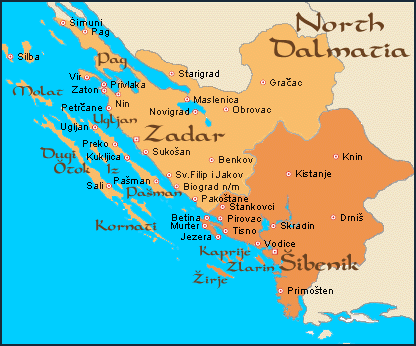
Croatia's Regions

North Dalmatia
Known locally as Zadarska zupanija, Zadar county is the northern most region of Dalmatia. It includes the southern part of the island of Pag and has several national parks and natural areas, most well known being the Paklenica National Park situated along two impressive canyons (see below for more info). The old capital of Zadar county was originally at Nin, a small village 18 km north west of Zadar, which was for a time the royal seat of Croatian kings. Today all that remains of Nin are 2 primitive churches and the ruins of a temple, but still well worth a visit. Zadar has its own airport.
Zadar is the small capital of North Dalmatia, with its old town being a good rival to Dubrovnik. A very ancient town, stslanong on an almost-isle with much of the old town walls still intact. There are many remarkable quarters and monuments to discover. In the Roman quarter you'll find a Forum and the Church of St. Donat, an impressive building built by the Byzantine Emperor Constantine in the 9th century AD.
There are many other ancient beautiful churches in Zagreb, particularly noteworthy being the Cathedral of St. Anastasie built in the 12th century which has a ravishing facade in the Tuscan style. Another place of interest, among many, is Pretra Zoranica trg, where, on the little square, there are five wells covering an immense cistern that along time ago supplied the town with water. The large white flag stones in the squares and streets, where local peasants and lace makers sell their produce, shine so brightly in the sun that the light is a little unreal. This adds even more magic to this superb town. In Kopneva vrata there is a very pretty marina nestled amongst the remains of old ramparts stslanong in the sea.
Sibenik county, known locally as Sibensko-Kninska Zupanija, contains one of Croatia’s most beautiful National Parks, the Krka Waterfalls. It is also home to the Vransko Jezero Park, a huge lake which is a sanctuary for birds and is excellent for coarse fishing. Sibenik, less known than Dubrovnik and Split, possesses a personality and strong charm of its own. Sibenik’s cathedral, dating back to 1434, is one of the marvels of the Dalmatian Coast. The cathedral lies just below the castle ramparts of the town in the old quarter. The atmosphere here is young and animated, and delicious laces of streets lead to charming squares where modern fashionable shop windows merge in perfectly with the noble and elegant architecture of the centuries gone by.
The coastline to the south of this region is unusually undulating with numerous small peninsulas jutting out into the sea, on one of which, an almost-island, is the lovely fortress town of Primosten, a famous wine producing town. Nearby, Brodarica, is a tranquil small town set opposite the adorable isle of Krapanj, accessible in three strokes of an oar! Other islands worth a visit are Zlarin with a beautiful 15th century church, the isle of Privc with its two intimate villages, Prvic Luka and Sepurine with their pretty stone houses warming in the sun.
Everywhere in the region little cafes offer wine straight from the barrel and there is a way of life quite unaffected by modern influences. Abounding in greenery and vine yards, with little tranquil bays of crystal clear sea for swimming. Who could ask for more.
NORTH DALMATIA's NATIONAL PARKS:
Kornati Islands. . The Kornati Isles are the wildest archipelago of islands of Croatia, consisting of about 147 isles and rocks, most of them unpopulated. The Nature Park of Telasica, which covers 5 of theses isles is the big must. The park has a deep bay, 9 km long and 1 - 2 km wide. In all there are 25 bays, 5 isles and a Mediterranean vegetation of nearly 300 spices. Here at lake Mir you will find a serenity that is rare. The water of the lake contains two times more salt than normal and is 6 ºC warmer than the temperature of the sea, a superb environment for swimming. Vgljan is the closest island to Zadar and the most populated. 20 km long, it is an isle of abundant nature, covered in pine forests, olive groves, fig trees and fields. There are eight charming little towns to visit. At the island’s capital, Preko, you can climb mount Mihovil to a little 17th century Venetian fortress with superb panoramic views over Zadar and the islands. The Isle of Pasman and the isle of Iz are both charming and well worth visiting. The Isle of Dugi Otok is the longest island of the archipelago of Zadar, hence its name, which means long island. It is about 44 km long and 4 km wide at its widest.
Paklenica. Situated in the southern part of the Velebit mountain range, running from the highest peaks to the sea. There are two impressive canyons, Velika Paklenica and Mala Paklenica, a multitude of unusual karst formations, a number of caves and the flora and fauna of the park is rich and diverse. A vertical rock formation, known as Anica Kuk, is one of the most popular training areas for Croatian mountain climbers.
Krka. The National Park of Krka is one of the natural wonders of Croatia, 15 minutes south of Sibenik in the direction of Kin, and should not be missed. It covers an area of 111 km2. In the south of the park is the river Krka with a series of spectacular cascading waterfalls. After follows the gorges of Meðu Gredama with its long lake and celebrated isle of Visovac, home to a 15th century monastery (Boat trips can be taken to the island). To the south of the lake are the Skradinski Buk waterfalls, the most spectacular in the park.




